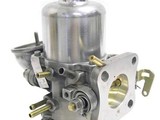SU Carbs - HIF, a more finely honed instrument.
The basic SU design has maintained the same basic format since it's inception. Even it's external appearance remained unchanged until the late seventies, early eighties - the classic illustration of a basic and simple concept that was very hard to improve on. Modern technology continually sweeps its ever-growing arm across all manufactured products and the SU was no exception. From closer scrutiny, and more demanding emissions control the HIF variant was born. So what have they done to improve it over its predecessor - the HS - and is it worth hanging out for?
PROS
Integral float - the 'IF' in the new type number HIF. The previous H and HS type carbs with their side-mounted remote float bowls worked fine until used in racing where serious cornering speeds generated enough G-forces to lean-out the fuel mixture. The remedy was to fit a spacer between the float lid and float bowl to raise the fuel level held in it. OK when running, but at idle and rest, fuel would bubble out of the jet - causing bore washing, poor pick-up, and horrendously rich CO mixtures at idle! Fitting the float integral with the carb, directly below the jet hole (port/orifice), eliminated this problem.
Jet temperature compensation -
This was first aired on HS types, and was known as the 'Wax-stat' type. To keep in line with emission control legislation and the need to improve fuel consumption figures, a device was needed to lean the fuel mixture off as fuel temperatures went up. Unfortunately the Wax-stat wasn't very efficient, and increased the likelihood of bending the already vulnerable jet further. The HIF type uses a bi-metal blade to raise and lower the jet as needed - it’s construction and location making it a far superior design. Its technical application label is 'viscosity compensator'. This close control means that once correct fueling is established by needle selection, the mixture is maintained over a very wide operating temperature range. Consequently drivability is enhanced and emissions are kept within tighter limits during cold starting and warm-up period.
Cold-start enrichment -
HS types used a cable-operated lever that both lowered the jet (gave a greater hole to needle profile ratio to allow greater fuel flow) and opened the butterfly slightly (necessary to prevent low speed stalling with over-rich mixture). Messy and not very well calibrated. Enrichment in the HIF is supplied by means of a separate fuel-path within the carb body between float chamber and constant depression area close to the jet hole. A rotary valve - effectively a long, plain-shanked screw with a slot in it, controls metering. Earlier example used a 'V' shaped groove, changed on the very latest ones to a rectangular groove to achieve better control through more accurate machining when manufactured - a feature that none of us would notice!
Ball bearing suction chambers -
A plastic sleeve containing two rows of six small ball bearings were introduced to reduce friction to the absolute minimum in the piston/suction disc/damper rod assembly. The benefit is simply more rapid response to varying demands caused by opening/closing throttle positions. Again in an effort to provide ever closer fueling control.
CONS
Vac pipe take-off -
There's always something to spoil the party! On some HIF carbs, the vac take-off sighted just after the butterfly - that's between the butterfly and the carb to manifold mounting flange - has been eliminated. Instead, the engines these carbs are fitted to use a vac take off in the manifold. The reason for this is again wholly idle emissions orientated. The higher vacuum that exists in the manifold area can be used to pull more advance. Theoretically this will reduce emissions at idle. Unfortunately it's exposed to induction pulsing. In the A-series, this is UGLY. The pulsing and high manifold vacuum causes rough idling. Particularly where anything 'sportier' (ANYTHING) than a bog-stock-standard cam profile is used.
Classic example - the MG Metro. Its adventurously sporty cam makes for a slightly lumpy idle. This increases idle speed emissions, so Rover use manifold-sourced vacuum to increase idle speed ignition timing via the vac advance. We're talking 28 degrees of ignition timing here! Doesn't work because the pulsing created by the cam causes erratic ignition timing, culminating in running on. So an anti-run-on valve was fitted as a modification. Vicious circle. After messing about trying to solve the emission problems this caused, it was found that changing the originally quoted valve clearances to 0.014"inlet /0.017" exhaust (effectively reducing the cam over-lap) helped dramatically. And, like I said earlier, the sportier the profile, the worse it becomes. Even worse - when running, this system can cause ignition advances in the order of 50 degrees on lift-off and on again - an absolute sure-fire recipe for savage detonation.
The solution is easy - remove the vac take-off from the manifold and fit it back to just in front of the butterfly where it should be.
So is an HIF worth it? Of course it is.









